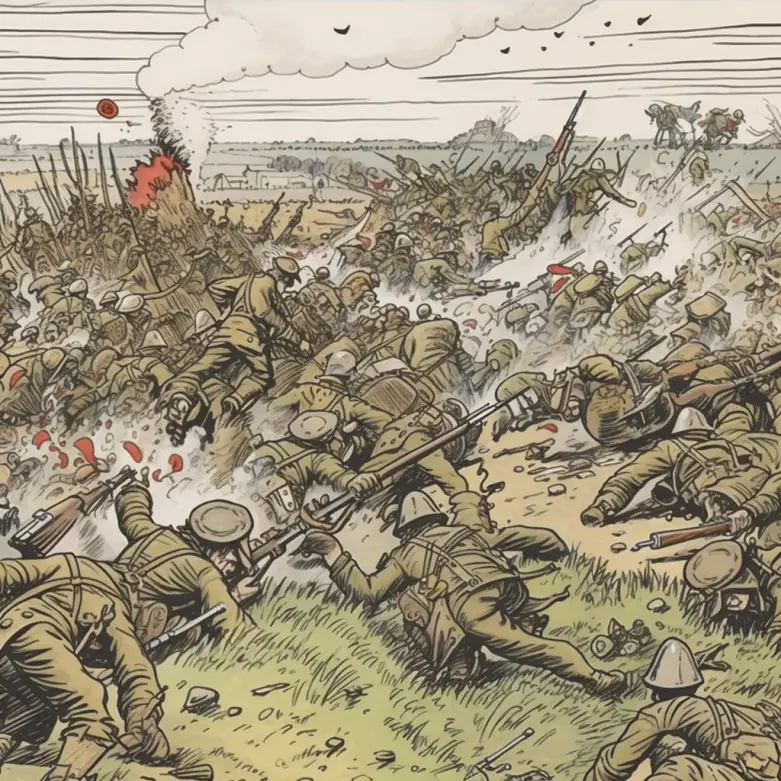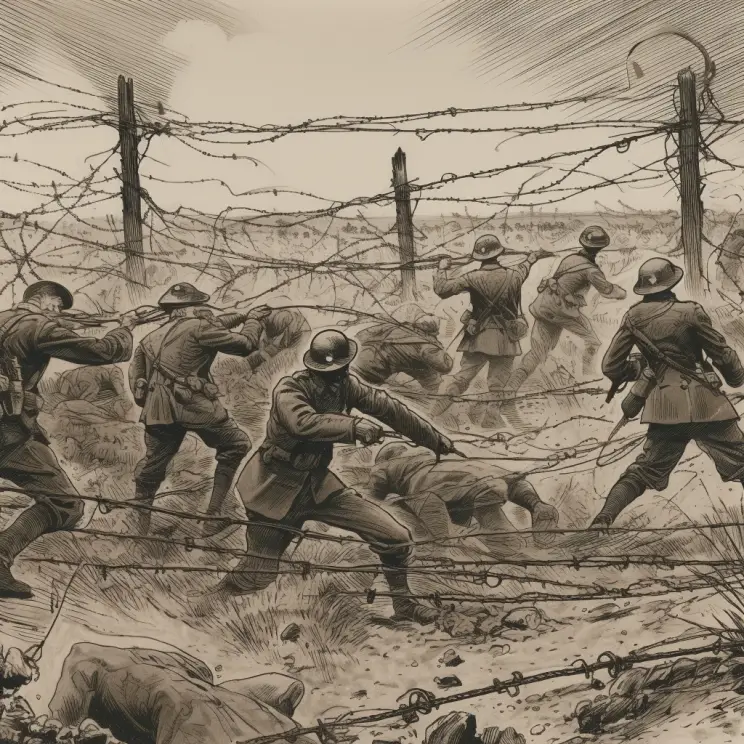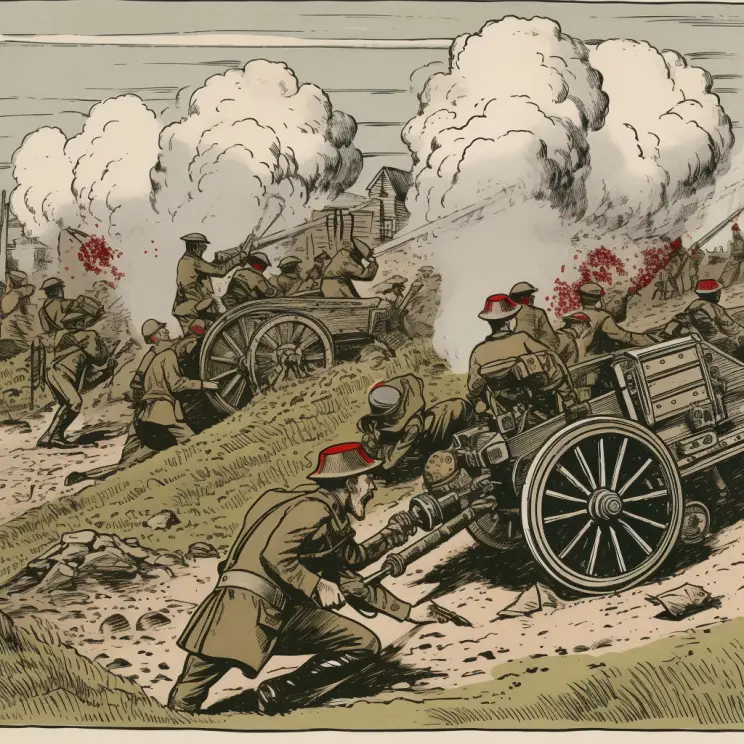German Backstory
The Battle of the Somme resulted in the loss of over 500,000 German lives, even with their entrenched position.
Somme was a lot like Verdun and was built to withstand frontal assaults.
With a lot of the German forces already deployed in Verdun, Somme was fortified enough to where it would take days to overthrow.

Battle of Somme Facts for Kids
- Somme was a WWI battle in France.
- British, and French fought the Germans.
- The battle began on July 1, 1916.
- 420,000 British troops died.
- Germans had better defenses.
- Defenses included barbed wire, landmines, and bunkers.
- German machine guns caused heavy casualties.
- Allies were outmanned.
- Hundreds of thousands died.
- Germans lost only 12km of ground.
The Somme: A Bloody Battle of Attrition with Devastating Losses for Britain

On the first day of battle on July 1st, 1916, 58,000 British soldiers were either wounded or died in the crossfire.
Germany had the better position, even with the 8-day bombardment of the German lines.
This failed in the beginning, as they had cleverly laid out one of the best defenses of the war.
Barbed wire, landmines, and concrete bunkers were constructed and offered the Germans superior protection for recovery and better cover when attacking.
With a little patience, they were able to use German machine guns to wipe out the advancing British and French Armies from all sides.
The main reason why Somme fell to the other side is due to being outmanned. Germany couldn’t spare troops from the attack on Verdun, and the French had successfully made headway through the southern end of the Somme defenses.
It took days of effort, hundreds of thousands of lives, and a few tanks for the Germans to lose only 12 kilometers of ground.
French & British Backstory
With a 30-kilometer front to start out, even after years of planning many lives were lost, and only 12 kilometers were gained.
Casualties for the French and British totaled 620,000, a number that caused many to question the strategies used in the battle.
French Commander-in-Chief Joseph Joffre with British Commander-in-Chief Sir Douglas Hag helped plan the offensive. The idea was to whittle down the German forces with a second priority of territorial gain.
Despite this being a joint offensive, the forces were heavily British due to the attack on Verdun. With the bulk of the French forces defending Verdun against the German attack, the French and British had another reason to attack Somme.
The original plan was to attack Somme on August 1st, 1916, but the French persuaded British forces to move it up a month earlier than July 1st. This would keep the German forces from sending resources to Verdun in its current attack.
The Germans were much better prepared for the assault than expected, and it was the smaller French Sixth Army that headed south that did the most damage.
Due to the number in favor of the British & French forces, the Germans were forced to bring some troops back from Verdun in defense of Somme.
It took several tanks and reinforcements to gain ground, and even then, they didn’t fully win Somme. The advance on the Germans was slow, and the assault was stopped due to snow on the 18th of November.
Who were the leaders?

Leading the charge for the British army was the authoritative Sir Douglas Haig – the Commander-in-Chief who called the shots for all the troops under his command. General Henry Rawlinson, a key player in Haig’s team, worked closely with the top brass to strategize and execute attacks with military precision.
Over on the French side, General Ferdinand Foch was an expert in the art of war and led the French soldiers with skill and finesse in battle. Working hand-in-hand with their British allies, Foch collaborated with Haig and his team to develop a winning plan to bring the war to an end.
Meanwhile, the German soldiers had their own formidable leaders to contend with. The Crown Prince of Bavaria, General Rupprecht, was in charge of a sizable number of soldiers, while General Max von Gallwitz and General Fritz von Below also had a major role to play.
Together, they worked tirelessly to try and defeat the Allied forces but ultimately fell short in the face of their enemy’s superior tactics and teamwork.
Artillery Barrage
The Allies wanted to attack the Germans, so they started by shooting at them with lots of guns for 8 days to help destroy the front lines of the German trenches.
They thought this would destroy the Germans’ defenses and they could easily take over. But the Germans knew about the plan, so they hid in their bunkers and waited it out. The shooting didn’t do much harm, and some of the Allies’ bullets didn’t even work!
The Battle

The Allies didn’t listen when they were warned that bombarding the Germans didn’t work. On July 1, 1916, thousands of British soldiers went into battle and were quickly killed by the Germans. It was a really bad day for Britain. They lost 60,000 soldiers that day.
Even though they lost so many soldiers, the Allies kept attacking for months. They gained some land but had over 600,000 casualties. The Germans lost 500,000. In the end, over a million soldiers died altogether in one of the bloodiest battles that resulted in a significant amount of casualties.
Why Was the Battle of Somme Important?
The Germans were exhausting a good amount of their forces to overtake Verdun. Somme was well-defended but had a lot less manpower and resources as the forces were split in two.
Somme was also deep into enemy territory and would give the British and French forces a major tactical advantage.
Who Was Affected?
Britain was affected the most, losing an incredible amount of soldiers on the first day alone. When the battle was over, and not won, Britain had lost 420,000 soldiers from Somme alone.
The French fared better for a different reason, as the results of Somme allowed them to win the Battle at Verdun.
Their smaller force coming from the South was also a key reason the British forces advancing from the front weren’t completely wiped out.
Names to Remember
Sir Douglas Haig’ strategy is one of the most scrutinized of all time concerning battles, even to this day.
Many argue that there were several times when his frontal assault could have been pulled back for defensive positioning, but he refused to change tactics.
Summary
If the snow had not intervened to stop the Battle of Somme, the British and French could have very well won in the end.
The battle served its purpose regardless and allowed the French to defend Verdun from German control.



